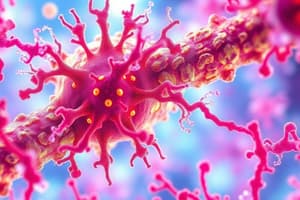Podcast
Questions and Answers
Which cells are mainly recruited to the site of infection in the acute inflammatory response?
Which cells are mainly recruited to the site of infection in the acute inflammatory response?
- T cells and B cells
- Neutrophils and monocytes (correct)
- Eosinophils and basophils
- Dendritic cells and macrophages
What is the main mechanism for defending against intracellular bacteria?
What is the main mechanism for defending against intracellular bacteria?
- Complement system activation
- Mast cell degranulation
- Phagocytes activated by TLRs and other innate sensors (correct)
- NK cells and type I IFNs
What contributes to redness, warmth, and swelling, characteristic features of acute inflammation?
What contributes to redness, warmth, and swelling, characteristic features of acute inflammation?
- Activation of T cells
- Exudation of plasma proteins (correct)
- Release of type I IFNs
- Inhibition of mast cell degranulation
What provides protection against viruses in the innate immune system?
What provides protection against viruses in the innate immune system?
What is the main mechanism that directs leukocytes from the endothelium into tissue?
What is the main mechanism that directs leukocytes from the endothelium into tissue?
What is the consequence of deficiencies in integrins and selectin ligands?
What is the consequence of deficiencies in integrins and selectin ligands?
What process involves the destruction of pathogens with the help of plasma proteins like complement proteins?
What process involves the destruction of pathogens with the help of plasma proteins like complement proteins?
What enhances phagocytosis of microbes by neutrophils and macrophages?
What enhances phagocytosis of microbes by neutrophils and macrophages?
What do phagocytes produce to kill ingested microbes?
What do phagocytes produce to kill ingested microbes?
What is released by neutrophils for the destruction of microbes?
What is released by neutrophils for the destruction of microbes?
What does an inherited deficiency of phagocyte oxidase cause?
What does an inherited deficiency of phagocyte oxidase cause?
What may cause tissue injury due to the release of enzymes and ROS into the extracellular space?
What may cause tissue injury due to the release of enzymes and ROS into the extracellular space?
Apart from eliminating pathogens and damaged cells, what else do cells of the immune system initiate?
Apart from eliminating pathogens and damaged cells, what else do cells of the immune system initiate?
Which type of leukocyte provides defense against helminthic parasites?
Which type of leukocyte provides defense against helminthic parasites?
What are the main phagocytes involved in the inflammatory response?
What are the main phagocytes involved in the inflammatory response?
What initiates the sequence of events in leukocyte migration into tissues?
What initiates the sequence of events in leukocyte migration into tissues?
What promotes the movement of leukocytes from the blood into the tissues?
What promotes the movement of leukocytes from the blood into the tissues?
What occurs in response to TNF and IL-1 during leukocyte rolling?
What occurs in response to TNF and IL-1 during leukocyte rolling?
What is responsible for arresting rolling leukocytes on the endothelium?
What is responsible for arresting rolling leukocytes on the endothelium?
What stimulates a rapid increase in the affinity of leukocyte integrins for their ligands on the endothelium?
What stimulates a rapid increase in the affinity of leukocyte integrins for their ligands on the endothelium?
What is involved in leukocyte migration to infection sites?
What is involved in leukocyte migration to infection sites?
What is responsible for reorganizing the cytoskeleton of leukocytes as they spread out on the endothelial surface?
What is responsible for reorganizing the cytoskeleton of leukocytes as they spread out on the endothelial surface?
What is produced at infection sites that is involved in leukocyte migration?
What is produced at infection sites that is involved in leukocyte migration?
What occurs within a site of infection that stimulates an increase in affinity of leukocyte integrins for their ligands on the endothelium?
What occurs within a site of infection that stimulates an increase in affinity of leukocyte integrins for their ligands on the endothelium?
Flashcards are hidden until you start studying
Study Notes
Inflammatory Response and Leukocyte Migration: Key Mechanisms
- Inflammatory response involves accumulation of phagocytes, mainly neutrophils and blood monocyte-derived macrophages, in tissues in response to cytokines produced by various cells such as macrophages, dendritic cells, and mast cells.
- Cytokines and other mediators increase vascular permeability and expression of endothelial adhesion molecules and chemokines, promoting the movement of leukocytes from the blood into the tissues.
- The acute inflammatory response involves a 7-step mechanism including injury, activation of sentinel cells, secretion of inflammatory mediators, increased vascular permeability, killing of microbes, leukocyte migration into tissue, and phagocytosis and killing of microbes.
- Neutrophils and monocytes migrate to extravascular sites of infection or tissue damage by binding to venular endothelial adhesion molecules and in response to chemoattractants produced by tissue cells.
- TNF and IL-1 act on the endothelium of venules near the site of infection, initiating the sequence of events in leukocyte migration into tissues.
- Rolling of leukocytes occurs in response to TNF and IL-1, where venular endothelial cells express adhesion molecules of the selectin family and circulating neutrophils and monocytes express surface carbohydrates that bind specifically to the selectins.
- At sites of infection, macrophages, dendritic cells, and other cells produce cytokines such as TNF and IL-1 that activate the endothelial cells of nearby venules to express selectins and ligands for integrins and to secrete chemokines.
- Leukocyte migration to infection sites involves weak tethering and rolling of blood neutrophils on the endothelium, firm adhesion of neutrophils, and migration through the endothelium to the site of infection, also used by blood monocytes and activated T lymphocytes.
- Leukocytes express integrins in a low-affinity state on unactivated cells, and within a site of infection, tissue macrophages and other cells produce chemokines, stimulating a rapid increase in the affinity of the leukocyte integrins for their ligands on the endothelium.
- TNF and IL-1 act on the endothelium to stimulate expression of ligands for integrins, including ICAM-1 and VCAM-1, which arrest the rolling leukocytes on the endothelium.
- The firm binding of integrins to their ligands arrests the rolling leukocytes on the endothelium, and the cytoskeleton of the leukocytes is reorganized as they spread out on the endothelial surface.
- Leukocyte migration involves the secretion of chemokines in fibrin and fibronectin at the infection site, and macrophages stimulated by microbes produce cytokines (TNF, IL-1) and chemokines, leading to firm adhesion of leukocytes
Studying That Suits You
Use AI to generate personalized quizzes and flashcards to suit your learning preferences.




